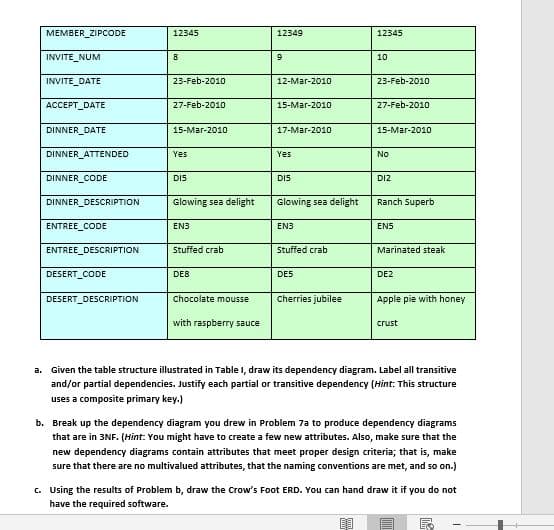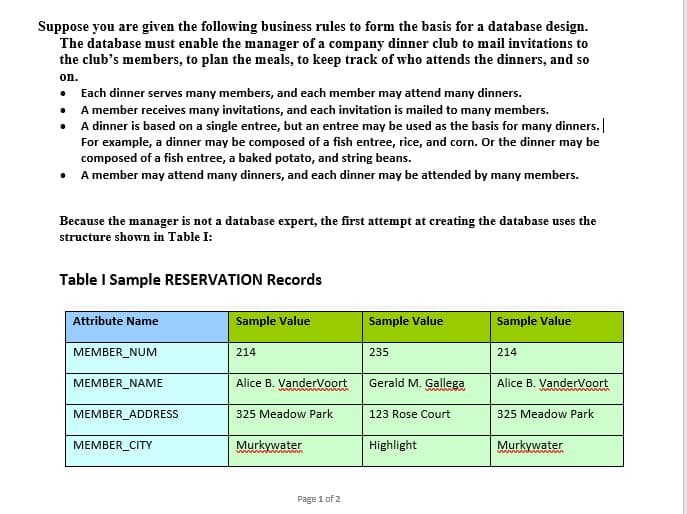Suppose you are given the following business rules to form the basis for a database design. The database must enable the manager of a company dinner club to mail invitations to the club’s members, to plan the meals, to keep track of who attends the dinners, and so on. Each dinner serves many members, and each member may attend many dinners. A member receives many invitations, and each invitation is mailed to many members. A dinner is based on a single entree, but an entree may be used as the basis for many dinners. For example, a dinner may be composed of a fish entree, rice, and corn. Or the dinner may be composed of a fish entree, a baked potato, and string beans. A member may attend many dinners, and each dinner may be attended by many members.
Suppose you are given the following business rules to form the basis for a
- Each dinner serves many members, and each member may attend many dinners.
- A member receives many invitations, and each invitation is mailed to many members.
- A dinner is based on a single entree, but an entree may be used as the basis for many dinners. For example, a dinner may be composed of a fish entree, rice, and corn. Or the dinner may be composed of a fish entree, a baked potato, and string beans.
- A member may attend many dinners, and each dinner may be attended by many members.
Because the manager is not a database expert, the first attempt at creating the database uses the structure shown in Table I:
Table I Sample RESERVATION Records
|
Attribute Name |
Sample Value |
Sample Value |
Sample Value |
|
MEMBER_NUM |
214 |
235 |
214 |
|
MEMBER_NAME |
Alice B. VanderVoort |
Gerald M. Gallega |
Alice B. VanderVoort |
|
MEMBER_ADDRESS |
325 Meadow Park |
123 Rose Court |
325 Meadow Park |
|
MEMBER_CITY |
Murkywater |
Highlight |
Murkywater |
|
MEMBER_ZIPCODE |
12345 |
12349 |
12345 |
|
INVITE_NUM |
8 |
9 |
10 |
|
INVITE_DATE |
23-Feb-2010 |
12-Mar-2010 |
23-Feb-2010 |
|
ACCEPT_DATE |
27-Feb-2010 |
15-Mar-2010 |
27-Feb-2010 |
|
DINNER_DATE |
15-Mar-2010 |
17-Mar-2010 |
15-Mar-2010 |
|
DINNER_ATTENDED |
Yes |
Yes |
No |
|
DINNER_CODE |
DI5 |
DI5 |
DI2 |
|
DINNER_DESCRIPTION |
Glowing sea delight |
Glowing sea delight |
Ranch Superb |
|
ENTREE_CODE |
EN3 |
EN3 |
EN5 |
|
ENTREE_DESCRIPTION |
Stuffed crab |
Stuffed crab |
Marinated steak |
|
DESERT_CODE |
DE8 |
DE5 |
DE2 |
|
DESERT_DESCRIPTION |
Chocolate mousse with raspberry sauce |
Cherries jubilee |
Apple pie with honey crust |
- Given the table structure illustrated in Table I, draw its dependency diagram. Label all transitive and/or partial dependencies. Justify each partial or transitive dependency (Hint: This structure uses a composite primary key.)
- Break up the dependency diagram you drew in Problem 7a to produce dependency diagrams that are in 3NF. (Hint: You might have to create a few new attributes. Also, make sure that the new dependency diagrams contain attributes that meet proper design criteria; that is, make sure that there are no multivalued attributes, that the naming conventions are met, and so on.)
- Using the results of Problem b, draw the Crow’s Foot ERD. You can hand draw it if you do not have the required software.


Trending now
This is a popular solution!
Step by step
Solved in 3 steps with 3 images









